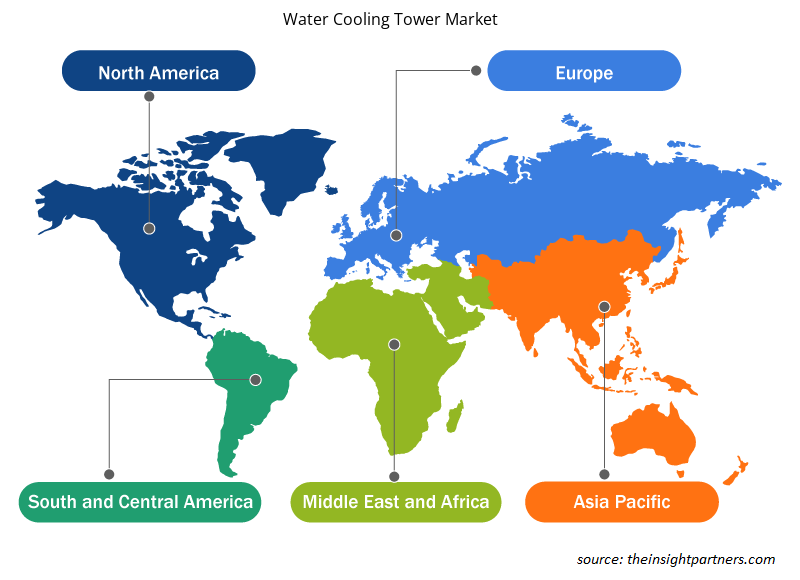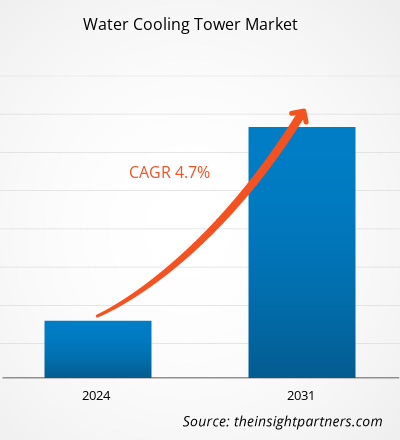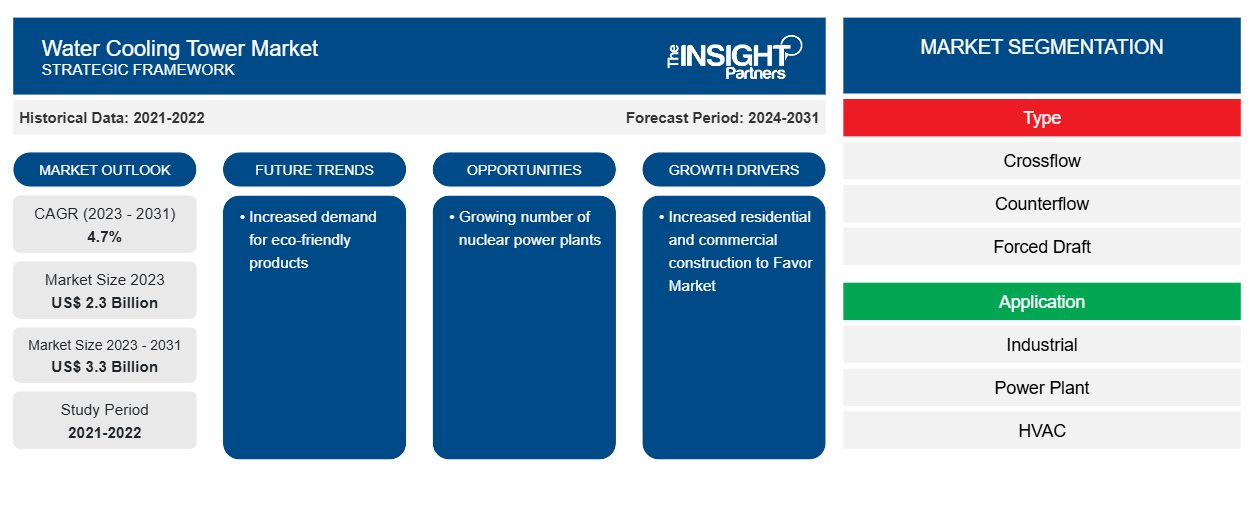La taille du marché des tours de refroidissement à eau devrait atteindre 3,3 milliards USD d'ici 2031, contre 2,3 milliards USD en 2023. Le marché devrait enregistrer un TCAC de 4,7 % au cours de la période 2023-2031. Avec les préoccupations croissantes concernant la durabilité et la réduction de l'empreinte carbone, la demande de produits écologiques pour le refroidissement des tours à eau a augmenté. Ainsi, une durabilité accrue devrait rester une tendance clé du marché.
Analyse du marché des tours de refroidissement à eau
La demande de tours de refroidissement à eau a augmenté dans le secteur de l'énergie. La demande en énergie étant en hausse, les dépenses consacrées à la construction de centrales électriques et, par conséquent, le nombre total de centrales électriques ont augmenté au cours des dernières années. Par exemple, selon les données publiées par le gouvernement américain, le pays se concentre sur la construction de 55 % de centrales électriques supplémentaires en 2024 par rapport à 2023. Ces dépenses de construction dans le secteur de l'énergie stimulent la demande pour le marché des tours de refroidissement à eau.
Aperçu du marché des tours de refroidissement à eau
En 2023, l'Amérique du Nord représentait une part de marché notable du marché mondial des tours de refroidissement à eau. Des pays comme les États-Unis et le Canada sont en tête du marché nord-américain des tours de refroidissement à eau. L'un des facteurs qui stimulent le marché est la forte croissance industrielle. Les centres de données nécessitent un système de refroidissement puissant pour maintenir l'efficacité opérationnelle. Ainsi, de nombreux centres de données sont équipés de tours de refroidissement pour maintenir la température. Les tours de refroidissement des centres de données utilisent l'air et l'eau pour transférer la chaleur des centres de données. Ces systèmes de refroidissement ont une plus grande efficacité que les méthodes traditionnelles de refroidissement par air , des coûts d'exploitation inférieurs et une plus grande flexibilité. Selon les données de Cloudscene , les États-Unis comptent environ 5 400 centres de données aux États-Unis. Ainsi, en raison de la présence d'un grand nombre de centres de données, la demande de tours de refroidissement à eau a augmenté au cours des dernières années.
Personnalisez ce rapport en fonction de vos besoins
Vous bénéficierez d'une personnalisation gratuite de n'importe quel rapport, y compris de certaines parties de ce rapport, d'une analyse au niveau des pays, d'un pack de données Excel, ainsi que de superbes offres et réductions pour les start-ups et les universités.
-
Obtenez les principales tendances clés du marché de ce rapport.Cet échantillon GRATUIT comprendra une analyse de données, allant des tendances du marché aux estimations et prévisions.
Facteurs moteurs et opportunités du marché des tours de refroidissement à eau
Augmentation de la construction résidentielle et commerciale pour favoriser le marché
Les constructions commerciales et résidentielles connaissent une croissance rapide en raison de l'urbanisation et de l'industrialisation importantes. Environ plus de 93 % du total des bâtiments sont des constructions résidentielles et commerciales ; en outre, environ 85 % de la surface totale des bâtiments est consacrée à la construction résidentielle et commerciale. Avec une pénétration aussi élevée de la construction résidentielle et commerciale, la demande de systèmes CVC a augmenté, ce qui a finalement stimulé le marché des tours de refroidissement à eau.
Le nombre de centrales nucléaires augmente
La demande en énergie augmente, tout comme la demande en centrales nucléaires. De plus, en raison de la prise de conscience accrue des émissions de carbone, l'attention portée aux centrales nucléaires s'est accrue, car elles sont plus efficaces et plus efficientes. Selon les données publiées par le Nuclear Energy Institute, aux États-Unis, environ 471 millions de tonnes de carbone sont évitées grâce à l'utilisation de centrales nucléaires. De plus, à l'heure actuelle, les sources d'énergie nucléaires contribuent à 10 % de l'électricité mondiale. Par conséquent, les gouvernements du monde entier augmentent la contribution des centrales nucléaires en construisant davantage de centrales. Par exemple, selon les données publiées par la World Nuclear Association, 60 centrales nucléaires sont en construction . Ainsi, la demande accrue de centrales nucléaires devrait générer des opportunités de revenus notables dans les années à venir.
Analyse de segmentation du rapport sur le marché des tours de refroidissement par eau
Les segments clés qui ont contribué à la dérivation de l’analyse du marché des tours de refroidissement à eau sont le type et l’application.
- En fonction du type, le marché des tours de refroidissement à eau est divisé en flux transversal, contre-courant, tirage forcé, tirage induit et autres. Le segment à flux transversal détenait une part de marché plus importante en 2023.
- En termes d'application, le marché est segmenté en secteurs industriel, centrale électrique et CVC. Le segment industriel détenait une part notable du marché en 2023.
Analyse des parts de marché des tours de refroidissement par eau par zone géographique
La portée géographique du rapport sur le marché des tours de refroidissement à eau est principalement divisée en cinq régions : Amérique du Nord, Asie-Pacifique, Europe, Moyen-Orient et Afrique, et Amérique du Sud et centrale.
L'Asie-Pacifique détient la part de marché dominante sur le marché mondial des tours de refroidissement à eau. Des pays comme la Chine, l'Inde, l'Indonésie et les Philippines connaissent une croissance notable. Cette croissance entraîne une augmentation de la demande en énergie, car le secteur industriel connaît une croissance rapide. De plus, en raison de l'urbanisation, la demande pour les secteurs résidentiel et commercial a augmenté. Avec une telle croissance dans les secteurs de la construction, de l'industrie et de l'énergie, la demande de systèmes de refroidissement rentables a augmenté, ce qui a finalement stimulé le marché des tours de refroidissement à eau.
Aperçu régional du marché des tours de refroidissement à eau
Les tendances et facteurs régionaux influençant le marché des tours de refroidissement par eau tout au long de la période de prévision ont été expliqués en détail par les analystes d’Insight Partners. Cette section traite également des segments et de la géographie du marché des tours de refroidissement par eau en Amérique du Nord, en Europe, en Asie-Pacifique, au Moyen-Orient et en Afrique, ainsi qu’en Amérique du Sud et en Amérique centrale.

- Obtenez les données régionales spécifiques au marché des tours de refroidissement à eau
Portée du rapport sur le marché des tours de refroidissement à eau
| Attribut de rapport | Détails |
|---|---|
| Taille du marché en 2023 | 2,3 milliards de dollars américains |
| Taille du marché d'ici 2031 | 3,3 milliards de dollars américains |
| Taux de croissance annuel composé mondial (2023-2031) | 4,7% |
| Données historiques | 2021-2022 |
| Période de prévision | 2024-2031 |
| Segments couverts |
Par type
|
| Régions et pays couverts |
Amérique du Nord
|
| Leaders du marché et profils d'entreprises clés |
|
Densité des acteurs du marché : comprendre son impact sur la dynamique des entreprises
Le marché des tours de refroidissement à eau connaît une croissance rapide, tirée par la demande croissante des utilisateurs finaux en raison de facteurs tels que l'évolution des préférences des consommateurs, les avancées technologiques et une plus grande sensibilisation aux avantages du produit. À mesure que la demande augmente, les entreprises élargissent leurs offres, innovent pour répondre aux besoins des consommateurs et capitalisent sur les tendances émergentes, ce qui alimente davantage la croissance du marché.
La densité des acteurs du marché fait référence à la répartition des entreprises ou des sociétés opérant sur un marché ou un secteur particulier. Elle indique le nombre de concurrents (acteurs du marché) présents sur un marché donné par rapport à sa taille ou à sa valeur marchande totale.
Les principales entreprises opérant sur le marché des tours de refroidissement à eau sont :
- Entreprises Babcock et Wilcox
- Inc.
- Société de bobines d'air de Baltimore
- Tours de refroidissement à cloche
- Tours de refroidissement Delta
- Inc.
Avis de non-responsabilité : les sociétés répertoriées ci-dessus ne sont pas classées dans un ordre particulier.

- Obtenez un aperçu des principaux acteurs du marché des tours de refroidissement à eau
Actualités et développements récents du marché des tours de refroidissement à eau
Le marché des tours de refroidissement à eau est évalué en collectant des données qualitatives et quantitatives après des recherches primaires et secondaires, qui comprennent des publications d'entreprise importantes, des données d'association et des bases de données. Quelques-uns des développements du marché des tours de refroidissement à eau sont répertoriés ci-dessous :
- Baltimore Aircoil Company (BAC) annonce la sortie de son nouveau refroidisseur adiabatique TrilliumSeries. Ce refroidisseur adiabatique est idéal pour les applications qui exigent une combinaison d'efficacité énergétique et de consommation d'eau limitée. La conception innovante de BAC maximise à la fois l'efficacité hydrique et énergétique, minimisant ainsi les coûts. De plus, le refroidisseur TrilliumSeries est conçu pour simplifier l'installation et la maintenance continue. (Source : Baltimore Aircoil Company, communiqué de presse, février 2022)
- Tower Tech, le principal fabricant de tours de refroidissement, est fier d'annoncer sa gamme de tours de refroidissement dotées de la technologie StormStrong en polymère renforcé de fibres (FRP) résistant à la corrosion. Les tours de refroidissement StormStrong sont capables de résister aux vents de la force d'un ouragan, aux tremblements de terre et aux contraintes liées aux intempéries avec un minimum de dommages, voire aucun. (Source : Tower Tech, communiqué de presse, septembre 2022)
Rapport sur le marché des tours de refroidissement à eau : couverture et livrables
Le rapport « Taille et prévisions du marché des tours de refroidissement par eau (2021-2031) » fournit une analyse détaillée du marché couvrant les domaines ci-dessous :
- Taille et prévisions du marché des tours de refroidissement par eau aux niveaux mondial, régional et national pour tous les segments de marché clés couverts dans le cadre
- Tendances du marché des tours de refroidissement par eau ainsi que la dynamique du marché telles que les moteurs, les contraintes et les opportunités clés
- Analyse PEST et SWOT détaillée
- Analyse du marché des tours de refroidissement par eau couvrant les principales tendances du marché, le cadre mondial et régional, les principaux acteurs, les réglementations et les développements récents du marché
- Analyse du paysage industriel et de la concurrence couvrant la concentration du marché, l'analyse de la carte thermique, les principaux acteurs et les développements récents sur le marché des tours de refroidissement à eau
- Profils d'entreprise détaillés
- Analyse historique (2 ans), année de base, prévision (7 ans) avec TCAC
- Analyse PEST et SWOT
- Taille du marché Valeur / Volume - Mondial, Régional, Pays
- Industrie et paysage concurrentiel
- Ensemble de données Excel
Rapports récents
Rapports connexes
Témoignages
Raison d'acheter
- Prise de décision éclairée
- Compréhension de la dynamique du marché
- Analyse concurrentielle
- Connaissances clients
- Prévisions de marché
- Atténuation des risques
- Planification stratégique
- Justification des investissements
- Identification des marchés émergents
- Amélioration des stratégies marketing
- Amélioration de l'efficacité opérationnelle
- Alignement sur les tendances réglementaires























 Obtenez un échantillon gratuit pour - Marché des tours de refroidissement à eau
Obtenez un échantillon gratuit pour - Marché des tours de refroidissement à eau